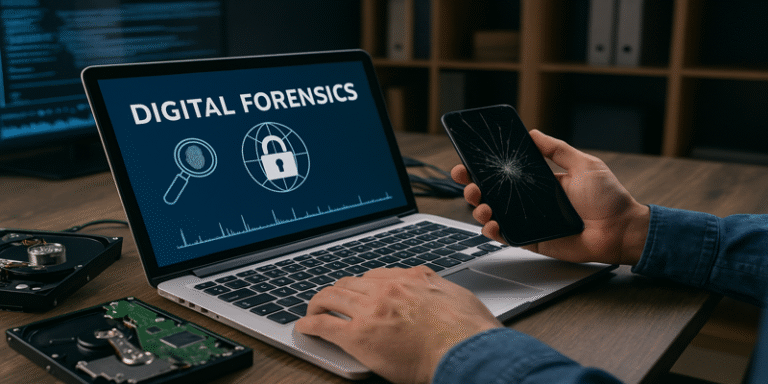Digital forensics has become a cornerstone of modern law enforcement, cybersecurity, and corporate investigation. It is the systematic process of identifying, collecting, preserving, analysing, and presenting digital evidence in a way that ensures its integrity and admissibility in court (Li, Dhami & Ho, 2015). As society increasingly relies on digital technologies, digital forensics has expanded across multiple domains—computer, mobile, network, and cloud forensics—to meet the growing demand for evidence-based digital investigation (Saharan & Yadav, 2022).
This article explores the principles, legal frameworks, ethical issues, and technological advancements shaping the field, drawing from textbooks, scholarly articles, and professional guidelines relevant to UK and global contexts.
1.0 Defining Digital Forensics and Its Core Domains
At its core, digital forensics involves the application of scientific techniques to extract and interpret digital information relevant to legal proceedings. According to Aleke and Trigui (2025), the field is concerned with maintaining evidence integrity, ensuring the chain of custody, and preventing any form of data tampering.
The discipline includes several subfields:
- Computer forensics, which focuses on the analysis of data stored on personal computers and enterprise systems;
- Mobile forensics, which retrieves data from smartphones and portable devices;
- Network forensics, which investigates network traffic and communications; and
- Cloud forensics, which addresses evidence distributed across virtual environments.
Each subfield requires specialised tools and methodologies. For instance, Wireshark and EnCase are often used to capture and interpret network and file system data, respectively (Widodo et al., 2024).
2.0 The Digital Forensics Process
The digital forensic process follows a structured sequence that ensures evidence reliability. Sibe and Kaunert (2024) describe five essential stages:
- Identification – recognising potential digital evidence sources, including hard drives, servers, IoT devices, or cloud storage.
- Collection – acquiring data using forensically sound imaging tools while maintaining integrity through hash values such as MD5 or SHA-256.
- Preservation – securing evidence in a manner that prevents tampering or alteration, adhering to strict chain-of-custody protocols.
- Analysis – applying forensic tools to interpret data and uncover relevant patterns, communications, or deleted information.
- Presentation – reporting findings clearly, ensuring they are legally admissible and comprehensible to non-technical audiences such as judges or juries.
For example, in a corporate fraud case, investigators might use Security Information and Event Management (SIEM) tools to correlate log data across systems, enabling them to identify the precise source and time of an intrusion (Rakha, 2024).
3.0 Legal Frameworks Governing Digital Forensics
Legal compliance forms the foundation of credible forensic investigation. In the United Kingdom, several statutes define the limits and responsibilities of digital investigators:
- Data Protection Act 2018 (DPA 2018): Regulates the lawful processing of personal data and imposes strict controls over privacy and consent (Horsman, 2022).
- Computer Misuse Act 1990: Criminalises unauthorised access and interference with computer systems.
- Investigatory Powers Act 2016: Governs the use of surveillance and interception techniques by public authorities.
These laws, together with the ACPO (Association of Chief Police Officers) Guidelines, ensure that digital evidence handling is consistent and defensible in court. According to Bauge et al. (2025), UK legal frameworks emphasise peer review, methodological transparency, and reproducibility, establishing credibility for forensic testimony.
Globally, variations exist—such as the NIST (National Institute of Standards and Technology) guidelines in the United States—but the underlying aim remains the same: to preserve authenticity and traceability of evidence (Elijah, 2025).
4.0 Ethical and Professional Standards
Digital forensic practitioners must adhere to ethical codes that safeguard both privacy and justice. Aleke and Trigui (2025) argue that forensic experts face a “dual obligation”: protecting individual rights while ensuring evidence is effectively gathered for public good.
Ethical considerations include:
- Confidentiality: Investigators must ensure sensitive data remains protected and disclosed only when necessary.
- Objectivity: Analysts should avoid bias and manipulation of findings.
- Competence: Continuous training is vital to keep pace with technological advances and evolving threats.
The British Computer Society (BCS) and the Forensic Science Regulator provide ethical frameworks that mirror international standards. Violations—such as evidence fabrication, unauthorised access, or conflict of interest—can lead to disqualification from testifying or professional sanctions (Harrison, 2024).
5.0 Maintaining Evidence Integrity
The integrity of digital evidence is central to its admissibility. Every action performed during forensic analysis must be documented and repeatable. According to Khan and Ahmed (2025), improper handling—such as using non-verified software tools—can render evidence inadmissible.
To ensure data authenticity, investigators employ cryptographic hashing and write-blocking devices. These tools verify that the evidence copy remains identical to the original. Harrison (2024) further notes that digital signatures and blockchain-based evidence chains have become innovative solutions to preserve the chain of custody, particularly in cross-border investigations.
An example of this is the use of blockchain audit trails in forensic accounting and fraud detection, where timestamps ensure non-repudiation and accountability (Igonor, Amin & Garg, 2025).
6.0 Technological Developments and Emerging Challenges
The exponential growth of cloud computing, Internet of Things (IoT), and artificial intelligence (AI) has revolutionised digital forensics, while also presenting new challenges. Bohlin (2025) highlights that smart home devices generate vast and decentralised data, complicating evidence collection and ownership verification.
Furthermore, encryption and anti-forensic techniques such as data obfuscation and file wiping hinder investigative efficiency (Pandey & Singh, 2025). To counter this, emerging tools use machine learning to automate anomaly detection, metadata extraction, and correlation of events across platforms.
However, automation introduces risks of false positives and algorithmic bias, necessitating human oversight and expert validation in forensic conclusions (Widodo et al., 2024).
7.0 Digital Forensics in Law Enforcement
In law enforcement, digital forensics supports a range of cases—from cyberstalking to terrorism investigations. Agencies such as GCHQ, MI5, and MI6 employ digital forensic units to detect threats and recover data from encrypted devices.
Fatoki and Anyasi (2025) assert that integrating forensic practices with judicial processes ensures fair trials and timely prosecution. For instance, during the 2020 EncroChat operation, digital forensic experts successfully decrypted communications between organised crime groups across Europe—demonstrating the power of forensic collaboration and lawful data interception.
Similarly, peer-reviewed verification, as discussed by Bauge et al. (2025), has enhanced transparency in UK forensic laboratories, fostering public trust in digital evidence procedures.
8.0 The Role of Cryptography and Blockchain in Forensics
Modern forensic investigations increasingly rely on cryptographic principles to verify authenticity. Cryptography provides confidentiality, integrity, and non-repudiation, while blockchain technology offers immutable ledgers that can record every transaction or evidence-handling step (Harrison, 2024).
Igonor, Amin and Garg (2025) demonstrate that blockchain-based systems prevent tampering and provide real-time traceability of digital artefacts. For example, blockchain has been adopted in financial forensics to track cryptocurrency transactions linked to money laundering and ransomware payments.
9.0 Challenges in Admissibility and Jurisdiction
One of the enduring challenges in digital forensics is ensuring cross-border admissibility of evidence. Differences in data protection laws, jurisdictional reach, and privacy expectations complicate international cooperation (Rakha, 2024).
Furthermore, the ephemeral nature of digital evidence, particularly in cloud environments, means investigators must act quickly to avoid data loss. Courts also face difficulties assessing the reliability of forensic tools, especially when proprietary algorithms are undisclosed due to intellectual property restrictions (Benhafsi, 2025).
Digital forensics is a dynamic, interdisciplinary field that bridges technology, law, and ethics. Its growing importance reflects the pervasive digitalisation of modern life and the need for scientifically credible evidence in both criminal and civil investigations. To maintain public confidence, practitioners must uphold ethical integrity, adhere to legal frameworks, and continually adapt to emerging technologies.
As Al-Raggad (2025) argues, the future of digital forensics will depend on integrating AI-driven automation, blockchain verification, and international collaboration to ensure that justice in the digital age remains transparent, efficient, and equitable.
References
Aleke, N.T. & Trigui, M. (2025) Legal and Ethical Challenges in Digital Forensics Investigations. IGI Global.
Bauge, R.K., Ryser, E., Sunde, N. & Horsman, G. (2025) ‘Evaluating the scope of peer review in digital forensics: Insights from Norway and the UK’, Science & Justice, Elsevier.
Benhafsi, S. (2025) Digital Forensics as the Newest, Most Troublesome Forensic Discipline.
Bohlin, E. (2025) Investigating the Current Methods and Challenges for Digital Forensic Investigations in Smart Homes: A Systematic Literature Review. DiVA Portal.
Fatoki, Y. & Anyasi, D. (2025) ‘A Legal Prognosis of the Significance of Forensic Evidence in Criminal Investigation’, AGORA International Journal of Juridical ciences.
Harrison, E.J. (2024) ‘The Role of Cryptography in Digital Forensics Investigations’, American Journal of Cryptography and Network Security.
Horsman, G. (2022) ‘Defining principles for preserving privacy in digital forensic examinations’, Forensic Science International: Digital Investigation, Elsevier.
Igonor, O.S., Amin, M.B. & Garg, S. (2025) ‘The application of blockchain technology in the field of digital forensics’, Blockchains, MDPI.
Khan, M.N.I. & Ahmed, I. (2025) ‘A Systematic Review of Judicial Reforms and Legal Access Strategies in the Age of Cybercrime and Digital Evidence’, International Journal of Scientific Interdisciplinary Research.
Li, S., Dhami, M.K. & Ho, A.T.S. (2015) Standards and Best Practices in Digital and Multimedia Forensics. Wiley.
Rakha, N.A. (2024) ‘Cybercrime and the Law: Addressing the Challenges of Digital Forensics in Criminal Investigations’, Mexican Law Review.
Saharan, S. & Yadav, B. (2022) Digital and Cyber Forensics: A Contemporary Evolution in Forensic Sciences. Springer.
Sibe, R.T. & Kaunert, C. (2024) Digital Evidence, Digital Forensics, and Digital Forensic Readiness. Springer.
Widodo, A.M., Biyanto, T.R., & Pappachan, P. (2024) ‘Recent Advances in Digital Forensics and Cybercrime Investigation’, Taylor & Francis Group.









